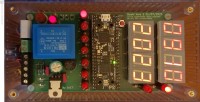Ouah ! - DCF77-based clock on an FPGA

Ouah! (Wow!) No, this is not a project to imitate a dog's bark. Ouah! is in French, the ironic acronym for “Oh, Une Autre Horloge!” ("Wow, another clock!") Ouah! is a clock that decodes the DCF77 signal. Its originality is that it is 100% hardware implemented on an FPGA using the Upduino 31 board.
This project consists in a DCF77 clock realised 100% by hardware. It is implemented on an FPGA and described in VHDL. This realisation does not include the receiver and the demodulator of the DCF77 signal. It concerns exclusively the decoding of the signal available at the output of the demodulator and its display on 7 segments and LEDs of the hours, minutes, month, day of the month, year, day of the week and daylight saving (CEST/CET) time. A printed circuit is also proposed.
DCF77 receiver-demodulators are readily available on the market. But in France, reception of DCF77 signals transmitted from Germany is difficult outdoors due to the low power received and almost
impossible indoors. Also, for the development of OUAH! did I need a DCF77 signal simulator. This simulator, written in C, implemented on Raspberry Pico W can be integrated in the same enclosure as the Ouah! Thus the clock can be used outdoor with the DCF77 receiver or indoor with the simulator provided that the Pico W is within the range of a Wi-Fi network.
The clock includes also a 220v power supply and If the mains is temporarily disconnected, a 9V battery (6x1,5v AAA batteries) can take over.
Project's Github :
https://github.com/duodiscus92/projet-ouah
Light support
support.ouah@orange.fr
DCF77 receiver-demodulators are readily available on the market. But in France, reception of DCF77 signals transmitted from Germany is difficult outdoors due to the low power received and almost
impossible indoors. Also, for the development of OUAH! did I need a DCF77 signal simulator. This simulator, written in C, implemented on Raspberry Pico W can be integrated in the same enclosure as the Ouah! Thus the clock can be used outdoor with the DCF77 receiver or indoor with the simulator provided that the Pico W is within the range of a Wi-Fi network.
The clock includes also a 220v power supply and If the mains is temporarily disconnected, a 9V battery (6x1,5v AAA batteries) can take over.
Project's Github :
https://github.com/duodiscus92/projet-ouah
Light support
support.ouah@orange.fr




Discussion (1 comment)
J.F. Simon, Elektor 1 year ago
Funny, I was looking at various FPGA boards, and you just happen to post a project using an Upduino. Nice!
You bought your DCF77 receiver at Reichelt, right? It's a bit more expensive than other similar modules that can be found in China, but at least it comes with a datasheet. What's the length on the antenna on this one? I wonder if it's more sensitive than cheaper ones, I might have to buy it and compare. Or wind my own on this 150mm ferrite bar that I have laying around :-)
duodiscus92 1 year ago
Sorry for my late answer. Thank you for your interest to this project. Yes, you are right I bought the receiver at Reichhelt. Indeed, generally speaking Reichhelt is more expensive than Chinese providers but also more reliable and delivery time is shorter. UPDuino is very efficient but fragile too. I have destroyed three of them ... be very careful when using it. The ferrite length is 55 mm. See photo attached. I tried to develop a very selective filter to be inserted between the antenna and the demodulator but it did not work. Also I'm looking for an old medium wave and long wave AM radio receiver to recover the HF part and try to make a DCF77 receiver with it but it's impossible to find as people don't throw them away. Finally, I use the clock mainly indoor with the simulator implemented on a Pico W. Please, let me know the results of you comparative test between various - possibly home-made - receivers. Best regards.
J.F. Simon, Elektor 1 year ago
duodiscus92 1 year ago
Oui une antenne active serait certainement efficace, mais je voulais rester très basse consommation et éviter tout circuits actifs ou être obligé de rajouter des alimes +/- 12v pour amplis op..
Merci pour le lien sur l'article de Stircker. Impressionnant. C'est un radioamateur pointu en circuit RF et démodulateur. Je ne me lancerai pas dans une adaptation pour le DCF77. Je ferai plutôt l'inverse : modifier le code VHDL du décodeur pour l'adapter au codage du signal TDF .... un jour si j'ai le temps ... à moins qu'un lecteur fasse le job ...
J'attaque un autre projet très différent ... A suivre.
Bonne année également. Bien à vous. Jacques